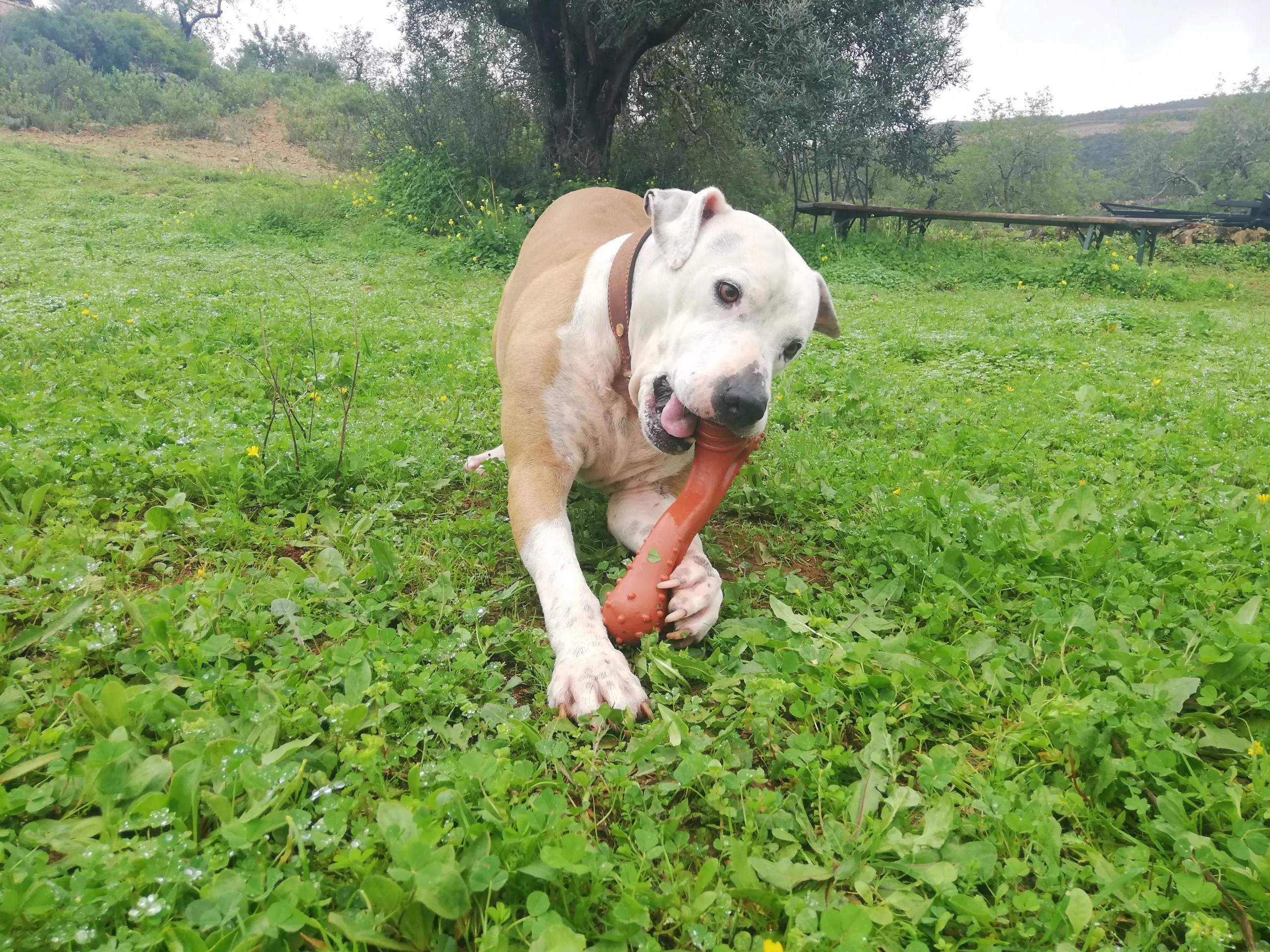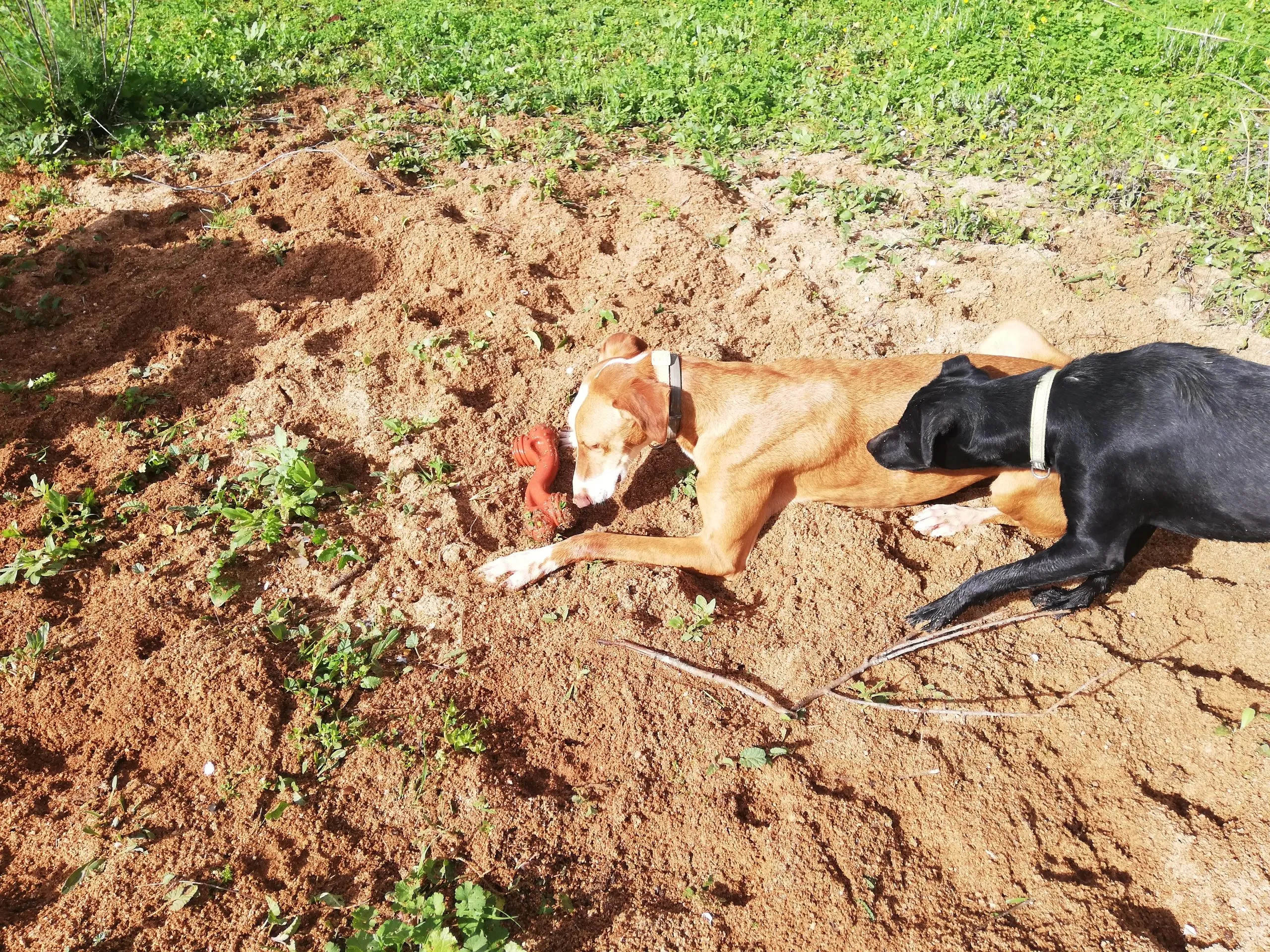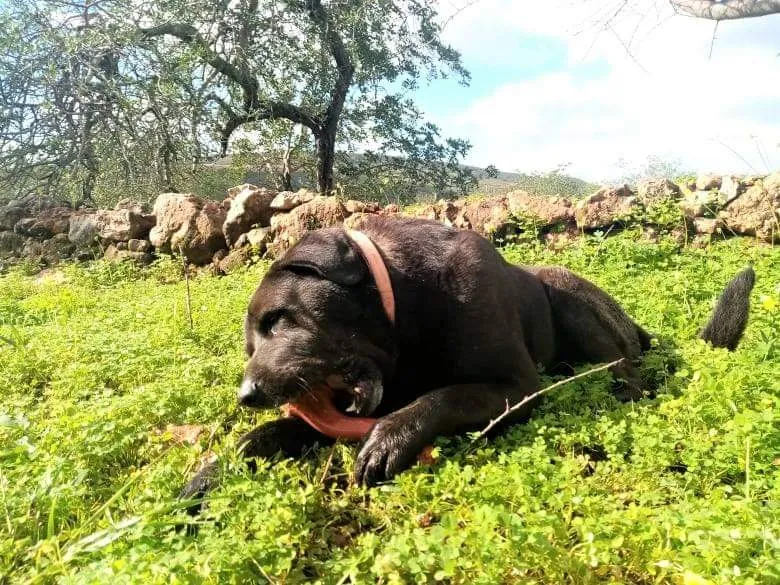Every dog owner knows the universal truth: dogs love to chew. It’s an innate behavior, a source of comfort, mental stimulation, and a fantastic way to keep those pearly whites clean. While “indestructible” toys have their place for power chewers, a different category of enrichment often goes overlooked but offers immense benefits: Chew Toys That Dogs Can Eat. These aren’t just toys; they’re palatable, digestible delights that satisfy a dog’s natural urges while providing nutritional or dental advantages.
At Dog Care Story, and through the bustling halls of Benafim Dog Shelter, we’ve seen countless dogs express their joy through chewing. Our extended family of shelter dogs – from the gentle nibblers to the most enthusiastic power chewers – has “tested” nearly every type of chew imaginable. We understand the challenge of finding safe, satisfying, and beneficial options. This article dives into the world of edible chews, exploring why they’re a fantastic choice for your canine companion and what to look for to ensure their safety and enjoyment.
Why Choose Chew Toys That Dogs Can Eat? Exploring the Benefits
Opting for edible chews isn’t just about giving your dog a tasty treat; it’s about providing a multifaceted benefit that contributes to their overall well-being.
- Dental Health: The mechanical action of chewing helps scrape away plaque and tartar buildup from your dog’s teeth. Many edible chews are specifically designed with textures and ingredients to maximize this dental cleaning effect, contributing significantly to improved oral hygiene and preventing gum disease.
- Mental Stimulation & Boredom Relief: Chewing is a natural stress reliever and a fantastic way to combat boredom. A long-lasting edible chew can keep a dog happily occupied for extended periods, reducing destructive chewing on inappropriate items around the house and preventing anxiety.
- Satisfying Natural Instincts: Dogs are biologically wired to chew. Providing appropriate outlets for this instinct, especially
chew toys that dogs can eat, fulfills a deep-seated need, making your dog feel more content and fulfilled. - Digestibility: Unlike plastic or rubber toys, edible chews are meant to be consumed. When chosen correctly, they break down safely in your dog’s digestive system, reducing the risk of blockages that can occur if pieces of non-edible toys are swallowed.
- Nutritional Value: Many edible chews, particularly those made from natural ingredients, can offer supplementary protein, vitamins, and minerals, making them a more wholesome treat than highly processed alternatives.
Understanding Safe Edible Chews: What to Look For
Choosing the right edible chew involves more than just picking something your dog will enjoy. Safety and health should always be paramount.
Ingredients Matter: Prioritizing Natural and Wholesome Options
Always scrutinize the ingredient list. Look for natural, single-ingredient options whenever possible. Avoid chews that contain artificial colors, flavors, or preservatives. Just as you would for your own food, less processed is often better for your dog. Consider chews made from real animal parts (like bully sticks) or plant-based ingredients (like sweet potato).
Digestibility is Key: Preventing Health Hazards
A chew toy that your dog can eat should also be a chew toy that your dog can digest. Some products, while technically edible, can be difficult to break down, leading to digestive upset or even dangerous blockages. Look for brands that specifically market their products as highly digestible. If your dog is a [best toys for tough chewing dogs], consider how quickly they consume chews and ensure the material is appropriate for their speed.
Appropriate Size & Hardness: A Match for Every Mouth
The chew must be appropriately sized for your dog. A chew that is too small can be swallowed whole, posing a choking hazard. One that is too large might be difficult for them to enjoy. The hardness is also critical:
- Too Hard: Chews like certain antlers or very dense bones can potentially fracture your dog’s teeth, leading to costly vet visits and pain. A good rule of thumb is that if you can’t indent the chew with your fingernail, it might be too hard.
- Too Soft: While safer for teeth, overly soft chews are consumed too quickly, losing their dental and mental stimulation benefits.
- For growing puppies, it’s particularly important to find
[best natural chew toys for puppies]that are gentle on developing teeth and gums.
Veterinarian Approval: When in Doubt, Ask!
If you’re unsure about a particular type of edible chew, always consult your veterinarian. They can offer personalized advice based on your dog’s breed, age, size, chewing habits, and any existing health conditions or dietary sensitivities.
 Two dogs, one white and one dark, interacting playfully with various colorful chew toys on a green lawn, showcasing canine joy and engagement.
Two dogs, one white and one dark, interacting playfully with various colorful chew toys on a green lawn, showcasing canine joy and engagement.
Top Categories of Chew Toys That Dogs Can Eat
The market for edible chews is vast, but they generally fall into a few key categories, each with its own advantages.
1. Natural Animal-Based Chews
These are often highly palatable and satisfying for dogs due to their natural flavors and textures.
- Bully Sticks: Made from beef pizzle, bully sticks are a classic favorite. They are high in protein, generally digestible, and come in various sizes and thicknesses to suit different chewers. Our shelter dogs often go crazy for these!
- Yak Chews (Himalayan Dog Chews): Crafted from hardened cheese (yak and cow milk), these chews are extremely long-lasting, virtually odorless, and lactose-free. They soften as dogs chew them, making them digestible. They are a great choice for
[best chew toys for power chewers]seeking a durable, natural option. - Antlers: Naturally shed antlers (deer, elk) are another long-lasting option. However, extreme caution is advised. While organic, they are very hard and can pose a risk of tooth fracture or splintering. If you choose antlers, ensure they are appropriately sized, cut, and supervised, and opt for softer options like split antlers or those from younger animals.
2. Plant-Based & Specialized Dental Chews
For dogs with sensitivities to animal proteins or owners looking for alternatives, plant-based chews are an excellent choice.
- Vegetable-Based Dental Chews: Many brands offer dental chews made from ingredients like sweet potato, pea flour, and other plant extracts. These are often designed with unique shapes and textures to maximize plaque removal. They are a healthy, often lower-calorie option for daily dental care.
- Edible Nylabones (Specific Edible Lines): While Nylabone is famous for its non-edible indestructible toys, they also offer a range of edible chews. It’s crucial to differentiate these; the edible versions are made from digestible ingredients like potato starch or real meat and are designed to be consumed. Always check the packaging to confirm you’re buying an edible Nylabone, not a non-edible one.
- Fruit & Vegetable “Chews”: Simple, healthy options like raw carrots, apple slices (without seeds/core), or dehydrated sweet potato pieces can serve as temporary edible chews. They offer fiber and vitamins but are consumed quickly and aren’t typically “toys” in the traditional sense.
 Nero, a white Pitt Bull, intently chewing on a large, curved Nylabone dog toy, demonstrating his powerful chewing prowess.
Nero, a white Pitt Bull, intently chewing on a large, curved Nylabone dog toy, demonstrating his powerful chewing prowess.
3. Rawhide Alternatives & Digestible Chews
Traditional rawhide has fallen out of favor due to concerns about digestibility, choking hazards, and chemical processing. Fortunately, numerous safe and digestible alternatives exist.
- “No-Hide” Chews: Brands like Earth Animal offer chews made from easily digestible proteins (like human-grade chicken, salmon, or pork) wrapped around a core, providing a long-lasting, rawhide-free option.
- Collagen Chews: Made from beef collagen, these chews are highly digestible and offer benefits for skin, coat, and joint health in addition to satisfying chewing instincts.
Our Shelter’s Experience: Picking Edible Chews for Diverse Chewers
At Benafim Shelter, with our diverse canine residents, we’ve learned that there’s no one-size-fits-all solution for edible chews. What delights one dog might not appeal to another, and what’s safe for a gentle nibbler might be a hazard for a power chewer. Our experience has taught us to carefully match the chew to the dog.
- For the Gentle Nibblers (like Maya, who’s still discovering toys): We lean towards softer, highly palatable options like smaller bully sticks, soft dental chews, or even dehydrated sweet potato chews. These satisfy their curiosity and chewing urge without overwhelming them or posing a risk to delicate teeth.
- For the Power Chewers (like Black Nero, who can tackle a tree trunk!): Finding edible
chew toys that dogs can eatfor these champions requires a balance. We opt for extra-thick bully sticks, large yak chews, or very dense, hard dental chews designed for aggressive chewers. Even then, strict supervision is essential, as even the toughest edible chew will eventually be broken down. We’ve seen Black Nero make quick work of many “long-lasting” options, so we know real-world durability is key. - For Puppies: Teething puppies benefit immensely from appropriate edible chews. We select softer, digestible chews specifically designed for young dogs, ensuring they are free from ingredients that could upset sensitive puppy stomachs. These are invaluable for redirecting their chewing away from furniture and supporting healthy tooth development. Whether it’s
[best chew toys for pit puppy]or[best chew toys for chihuahua puppies], the focus is always on gentle, digestible materials.
 Max, a brown and white dog, subtly trying to take a Nylabone chew toy from Maya, a brown dog, who holds it firmly, showcasing typical dog interaction over a favored item.
Max, a brown and white dog, subtly trying to take a Nylabone chew toy from Maya, a brown dog, who holds it firmly, showcasing typical dog interaction over a favored item.
Safety First: Essential Tips for Feeding Edible Chews
Even the best chew toys that dogs can eat require responsible use to ensure your dog’s safety and maximize the benefits.
- Supervision is Key: Never leave your dog unattended with an edible chew, especially for the first few times. Monitor their chewing style to ensure they are not breaking off large pieces that could be swallowed whole and become a choking hazard.
- Appropriate Size: Always choose a chew that is larger than your dog’s mouth to prevent them from swallowing it in one gulp.
- Rotate Chews: Offering a variety of chews helps prevent boredom and ensures your dog receives a range of nutritional benefits. It also helps distribute the wear and tear on their teeth.
- Be Aware of Allergies & Sensitivities: If your dog has known food allergies or sensitivities, carefully check the ingredients of any edible chew. Introduce new chews slowly to monitor for any adverse reactions.
- When to Discard: Once an edible chew becomes small enough to be swallowed whole, it’s time to take it away. Small, leftover pieces are the most common cause of choking or digestive obstruction.
- Fresh Water: Always ensure your dog has access to fresh water while chewing, as some chews can be dehydrating or encourage thirst.
 A black Cane Corso cross, Black Nero, powerfully chewing on a bone-shaped toy, demonstrating his strength and determination with the chew toy.
A black Cane Corso cross, Black Nero, powerfully chewing on a bone-shaped toy, demonstrating his strength and determination with the chew toy.
Conclusion: The Edible Advantage for Happy, Healthy Pups
Choosing chew toys that dogs can eat is a fantastic way to support your dog’s dental health, mental well-being, and natural instincts. By understanding the types of edible chews available, scrutinizing ingredients, and prioritizing safety through appropriate sizing and supervision, you can provide your furry friend with hours of wholesome enjoyment.
Remember, every dog is an individual, and what works for one may not work for another. Observe your dog’s chewing habits, consult your veterinarian, and opt for high-quality, digestible options. The reward will be a happier, healthier companion with a sparkling smile and a contented spirit. Explore more ways to enrich your dog’s life with safe and engaging activities on Dog Care Story!
 Pebbles, a black and white dog, calmly observing a red Kong Wobbler treat dispenser on a textured surface, showcasing thoughtful interaction.
Pebbles, a black and white dog, calmly observing a red Kong Wobbler treat dispenser on a textured surface, showcasing thoughtful interaction.
References
- American Veterinary Medical Association (AVMA). “Oral Health: What You Should Know.”
- Cummings Veterinary Medical Center at Tufts University. “Dental Health for Your Pet.”
- Pet Food Institute. “Understanding Dog Treats and Chews.”
